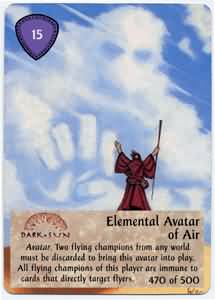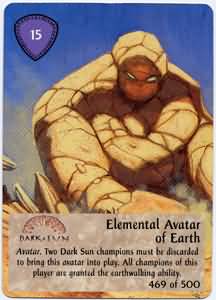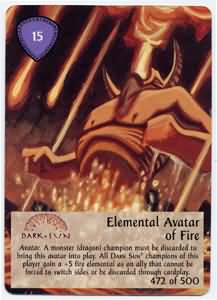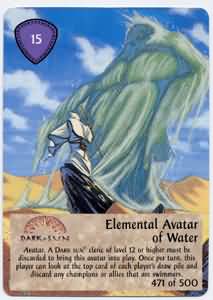Dragon 77

Dragon 77

| Curses | The Ecology of the Unicorn | Elemental Gods | The Tarot of Many Things | Cursed Magic Items |
| - | - | - | - | Dragon |
He or she?
Dear Editor:
I enjoyed Mr. Greenwood?s article concern-
ing the Nine Hells [issue #75]. However, I
found one apparent mistake. In the article,
Sekolah is described as a female.
The Deities &
Demigods Cyclopedia states that the deity is a
male. Can you explain?
Greg Lewis
North Augusta, S.C.
Yep, the article was ? technically ? in
error. But I think we can figure out where Ed
Greenwood was coming from when he referred
to Sekolah as a female shark (see
page
31 of
issue #75). In the entry for sahuagin
in the
Monster Manual, it is noted that ?the religious
life of these creatures is dominated by the
females.? The reference to ?females? in that
passage specifically concerns female sahuagin,
who are the clerics of the race.
But, carrying the interpretation of that
statement a little further, it makes sense for a
religion ?dominated? by females to have a
female deity at the top of their hierarchy, and
it seems safe to assume that this was how Ed?s
reasoning worked when he called Sekolah a
?she.? In light of the fact that the Monster
Manual is part of the official
AD&D?
rules and
the DEITIES & DEMIGODS?
Cyclopedia is
not a rule book in the same sense, it might be
argued that the MM takes precedence over the
DDG book on this point. Fortunately, for the
purposes of playability, it makes no difference
(that we can see) whether Sekolah is male or
female. We won?t disagree with anyone who
thinks the article was in error, and you can cer-
tainly change ?she? to ?he? anywhere the arti-
cle talks about Sekolah if you?re more comfort-
able with that. ? KM
Elemental gods
A four-part approach to campaign deities
by Nonie Quinlan




Most role-playing game referees, in laying out their cam-
paigns, have no trouble finding suitable gods. For “good-bloody-
fun” campaigns, which include most FRP worlds, the general
rule is: The more gods the merrier, and the more wars between
the gods the better. In these warlike universes, gods should be
killable by high-level characters and they should be clearly rec-
ognizable as belonging to one race and one alignment, On the
other hand, campaigns designed for medieval authenticity will
tend to reproduce the medieval church: a highly organized
clergy, with a single abstract deity who never takes a direct part
inthe action.
But there is a third, rarer type of campaign that could be called
the “high fantasy” style. It tends to involve consistent, non-
anachronistic worlds; you will never hear “Frodo’s Pizza Parlor,
may I help you?” or “You . . . you mean this whole dungeon is
one big pool hall?” The characters have real motivations, and
will not jump into an abyss just to see how deep it is. They are
part of an ongoing history which they respect; upon discovering
a great hero’s tomb, they will pour libations and pray for him,
not try to figure out how to loot the tomb. The role-playing is
well thought out, consistent and realistic, and the highest part of
the game is not the loot and experience, but the sense of wonder.
Gods for such a campaign are hard to find. It is necessary that
they be of a kind that a real person could take seriously, because
the characters are going to be serious about their religious
beliefs. The gods must be more than super-powered beings,
because a strong and independent adventurer is not likely to
worship a god just because the deity has more hit points than
any others and better powers. On the other hand, it must be
remembered that in the campaign world the gods are real, not
simply manifestations of cultural religious beliefs; why would
there be one god for gnomes and another
for orcs? Fire is fire.
For the gods to be taken seriously by both the players and their
characters, it is necessary that they be all-powerful, all-knowing,
and truly immortal. For this reason they should not be assigned
formal attributes; they need no armor class or hit points, because
no creature of this world could harm them. They have infinite
strength and unlimited power, and only the nature of what they
rule constrains them; a god of fire will rarely control water.
Because they are so powerful, it is clear that they must not be
hostile toward each other, or the world would have been de-
stroyed in their first conflict. Their powers must be balanced,
equal, and approximately at peace. For this reason, the four ele-
ments seem a good model for the nature of the gods, because the
elements have always existed together without serious conflict.
(Certainly water and fire, for example, may be mutually destruc-
tive on contact, but neither seems dedicated to locating and de-
stroying the other, and both still exist as they always have.)
The requirement that the gods be at peace with one another
also calls into question the assumption that a god has an abso-
lute alignment. If there are truly good gods and truly evil gods,
they will not endure each other’s existence. But the elements, like
any force of nature, unite both positive and negative aspects in
themselves; without fire, civilization would barely exist, and yet
fire is the great destroyer. And what could be more ambivalent
than the life-giving, life-taking sea?
It is for these reasons that our local D&D® gaming group has
developed a pantheon based loosely on the four elements and
given them the characteristics described below.
The nature of the gods
There are four gods: those of Earth, Air, Fire, and Water. They
are not hostile to each other, or to each other’s followers. Each
may be worshipped by someone of any race or alignment; they
have many natures, and every worshiper may see them differ-
ently. They encompass opposites; good characters and evil ones
may worship the same god, even if they pray at different fanes.
The gods are not limited in gender any more than in align-
ment; they may tend to be associated with one sex, but certain
aspects will be of the opposite gender, or both, or none.
They rarely take an active hand in matters; they give power to
their clerics and may answer prayers, but they do not wake up in
the morning and decide to start a war. They are all-powerful,
non-corporeal beings, but once in a while one aspect of a god
may take apparently physical form and walk on the earth; even
in that form they cannot be injured or constrained. The average
character stands a good chance of seeing a god at least once in
his life, which may seriously affect his religious beliefs.
The nature of religion
In developing religion within a culture in a campaign using
elemental gods, it must be remembered at all times that the gods
are real and the people know it. Oaths sworn to the gods must be
honored, or retribution will fall on the oathbreaker; this is an
absolute law, as certain as a law of nature.
The gods do not demand worship. It is the nature of men to
worship the divine, and so most men will perform religious ritu-
als, offer prayer, and otherwise deliberately affirm their relation-
ship to the gods. Other men may never perform an act of wor-
ship in their lives, but they too are aware that the gods exist.
When the gods are clearly real, there can be no atheists.
In my campaign, I assume that each character has a closer tie
to one of the gods than to the rest. It is to this god that the char-
acter prays most often, and this god is most likely to help the
character in times of need. However, characters are not therefore
hostile to the gods they don’t worship, or even to other aspects of
their own gods. They know the gods exist and they honor them,
but each character’s greatest devotion is given to his own deity.
An analogy to this in our own world might be the tradition of
patron saints.
Members of the priesthood, both spell-casting clerics and the
little village priests who perform marriages and bless the crops,
must be sincere in their beliefs, not hypocritical and avaricious,
because the gods know the truth of their oaths of service. This is
also true of such people as knights, kings, and judges; they may
be mistaken or misled, but they must be true to their vows.
Details of religions vary from culture to culture, but the aver-
age man’s life is much like what we would expect. He asks the
priest’s help with the rituals of birth, marriage, and death, and
the priest’s blessing on the spring planting or the launching of
the fishing fleet, and he will later offer thanks for the harvest or
the catch. With his family, he shares the lesser rituals of the table
and the day’s task, and alone in the night, or when he is greatly
moved, he will speak to his god in spontaneous prayer. Belief
will not dominate his life and his actions, but it will always be
present, because he knows the gods are real.
The Elements
A system of gods based precisely and exactly on the four ele-
ments is actually likely to be both dull and confusing. How
worked up can someone get about the divinity of granite? And
on the other hand, what element is a thunderstorm? The rain is
Water, the wind Air, the lightning Fire. Is a volcano Earth or
Fire? And what possible element is a human?
In our local gaming community, we have three established
Dungeon Masters using a system of elemental gods, and several
others just beginning. In no two campaigns are the gods entirely
alike, because no DM uses a technically pure elemental system; if
it were not colored by the personality of the gods and of their
worshipers, it would be not a religion but a science. In the de-
scriptons of the mythologies below, two campaigns’ versions of
each god are given to show how they can be varied according to
each referee’s desires.
A word of caution, from experience: Be careful about the ten-
dency to use standard god-figures. It is almost automatic to
assume that the Earth is a fertility god, the Fire a sun god, and so
on. But these set-ups will degenerate quickly into monotony for
players and DM unless the DM has a complete understanding of
how they work, what opposed natures they represent, and how to
make these “facts” real to the players. While I have had success
with an Earth fertility goddess myself, it is an uphill struggle,
and I have never seen a sun god well and interestingly handled
in a fantasy campaign. A certain amount of originality, if
handled consistently, will yield a much richer and more fascinat-
ing system.
The aspects of the gods
The Earth: In my campaign, the Earth is the goddess of birth
and growth. She is primarily a deity of live soil rather than
stone, and is responsible for farming and fertility. Called the
Mare, she rules most animals except the wildest beasts that
belong to the Air, and the animals of highest intelligence that
share man’s ability to choose their own gods. She is most wor-
shipped by humans and halflings, but the elves know that she
gives them their beloved forests, and the dwarves know that it is
her strong hand that holds the stone roof over their heads and
shelters them.
In her evil aspect, she rules the darker side of fertility; plague,
poison and decay, and on the other hand sterility and famine.
Animals particuarly associated with her are the mare, the bull,
and the serpent, and her tree is the apple. Religious symbols and
other objects made in her honor will often be made of copper or
bronze, set with jade, carnelian, or amber. Her colors are green,
brown, blood red, and harvest gold. In prayer, she might be
addressed as Allmother, Giver of Gifts, Earthshaker, Bearer of
Burdens, Mother of Horses, Shepherd of the Trees; in her darker
aspects, Pourer of Poison, Barren Field, Mother of Vipers.
Another campaign in our group has a very different Earth
goddess called the Bear, who is primarily a protector and
defender; she is the goddess of good warriors (who in this world
are gentle rather than fanatical), and she is the youngest and
most personal and friendly of all the gods; not a mother goddess,
but a beloved sister.
The Air: The Air god of my campaign is called the Raven, and
he has two natures; even in his good aspects, he is the god of
both the still air and the storm. In the first, he is the god of
thought and speech, and thus of learning and music. Clerics who
worship this aspect of the Air god tend to live contemplative
lives of meditation.
In his second aspect, he is the god of storms and of wild
things; stags and hawks, werewolves, berserkers, and the Wild
Hunt. It is not far from this to his evil aspect, which rules insan-
ity and the love of destruction. (It may seem difficult to unite
poetic wisdom and cruel violence in one god, but a close look at
Odin’s character in Norse mythology will show a similar
contradiction.)
The Raven’s animals are primarily the wolf, the stag, and the
hawk, and his tree is the pine. His metal is iron, his tones grey
quartz and obsidian. His colors are grey and black; midnight
blue in his sky aspects, pine-green and red as the Hunter. Some
of his titles are: Shapeshifter, Teacher, Father of Wolves, Mask,
Masterbard, Hunter, the Dark-Winged One.
In contrast to the wolf-like, masculine aspect of the Raven,
another campaign sess the Air god more as a cat-figure, more
Dionysus than Odin. This Air god is androgynous, playful, often
malicious, and treacherous when angered.
The Fire: The Fire god in my campaign is worshipped as the
Dragon, god of the forge. He is the patron of craftsmen, and
especially of smiths. Dwarves have a particular love for the
Dragon, but he is also responsible for the human’s plowshare
and the elf’s harp. The Fire god is in many ways the god of civil-
ization, because he is the god of tools; not just the hammer but
also tools such as the loom, the saw, the net, and the cookfire.
The Earth may be the goddess of creation, but the Fire rules
creativity.
In his evil aspect he is the volcano and the forest fire; blind,
uncaring destruction that can overwhelm a man or a city with-
out noticing.
The animals of the Fire god are the dragon, the griffon, and
the nightmare; his tree is the oak. Gold is his metal, and his
stones are ruby, topaz, and all clear fire-colored gems. His colors
are red, gold, and white. The Fire god is sometimes called Master
Craftsman, Forgefather, Goldenhand, the Maker, and also Fire-
fang, Flaming Horse, Eater of Cities.
Another campaign has a very similar god, but he also rules
magic and all the ways of the wizard, because magic is seen as a
human act of creation and an act involving the use of skill, and
the essence of magic in this campaign is fire.
The Water: Because of the connection of the moon and the
tides, the Water goddess of my campaign is the ruler of light, and
therefore of darkness. Called the Moon, she is the most revered of
all the gods. She is the goddess of magic, worshipped most of all
by elves and unicorns. Of all the gods, she is the most purely
good and the most purely evil; both the holiest and unholiest of
characters are her followers. She is the goddess of healing, the
protector of the innocent, the goddess of justice and thus of war,
when it is undertaken for noble reasons.
As the Dragon is the god of the hands of civilization, so she is
the goddess of its heart and mind, and of the things that make
humans more than mere beasts with tools. Thus, her evil aspect
is the destroyer of civilization – not blind destruction, but care-
ful, reasoned, and deliberate evil. One of the two greatest cities
in
my campaign world was brought to ruin by the deliberate
designs of the Moon's evil worshippers, and a conflict fostered
between two innocent races still smoulders centuries later.
The Moon’s animals are the unicorn, the dolphin, and the
gull; her tree is the birch. She is often represented as a horned
hippocampus. Her metal is silver (mithral is said to be made
from her tears), and her stones are pearl, sapphire and onyx. Her
colors are black, white, blue, and green; as the goddess of magic,
grey and purple are also her colors. Her titles include: Shepherd
of Unicorns, White Lady, Silvershield, Protector, Lady of the
Waters, Wavemantle, Shipbearer, and Fairest. In her evil aspect
she is Deathgiver, Shipbreaker, Mother of Demons, Night’s
Queen, Drinker of Blood, and Mistress of the Abyss.
Another campaign has a different Water goddess. Called the
Old One, she is the goddess-of the ocean, in a world where the
only land is a scattered group of islands. It is she, not the Earth,
who gives men food and life, and she who withholds it. She is
the creator and destroyer, the most terrible of elemental forces;
oldest and strongest of the gods, she is the least human of them
all, and to anger her is fatal. Even her clerics fear as well as
honor her.
Conclusion
In the examples above the world has clearly shaped the gods,
as the gods should shape the world. The details of these mytho-
logical systems are given only as an example of two such pan-
theons, not as a rule for all to follow. The great advantage of the
elemental pantheon is flexibility in a framework of consistency.
If adapting such a system to your own campaign, consider
seriously the geography and cultures involved. It can become an
exercise in anthropology: If these people worshipped a fire god,
how would they picture him? How are their beliefs like the
beliefs of other cultures and races?
Above all, remember that in the campaign world the gods are
real. Their worshipers are real. If the players are to maintain
consistent characters within the world, then the gods must also
be consistent, believable, and interesting, not just names and
attributes to which a character pays lip service when necessary.
They must be a living part of a living world.
Each campaign has its own style, and everyone thinks their
own the best, but it seems safe to say that few players whose 50th-
level characters manage to find and kill the evil god of gnomes
have ever felt anything like the awe and the chill felt, not only by
the characters but by the players, when, in troubled times in my
campaign, the city of Arna looked out across its great bay and
saw on a cold early morning, a long-forgotten masculine aspect
of the Moon rise up from the waters to tower high above the
world – his pearl-skinned body still waist-deep in the ocean
while his streaming hair was crowned with clouds.